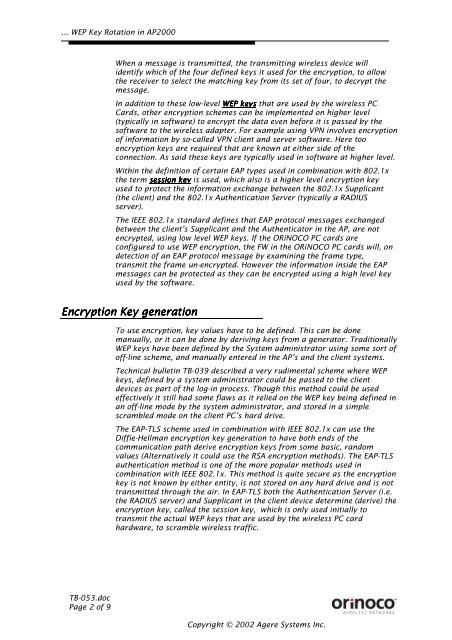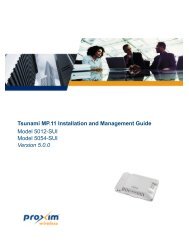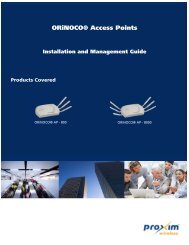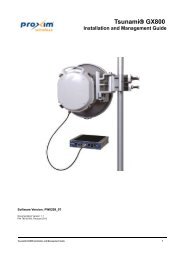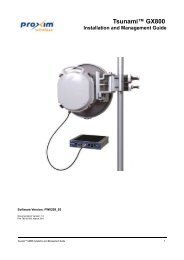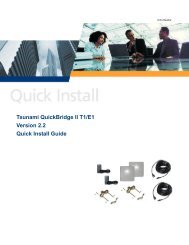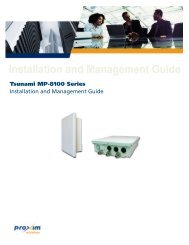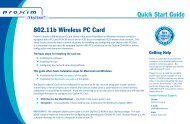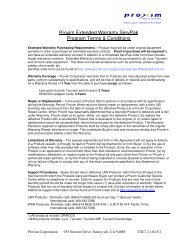... WEP Key Rotation in AP2000
... WEP Key Rotation in AP2000
... WEP Key Rotation in AP2000
Create successful ePaper yourself
Turn your PDF publications into a flip-book with our unique Google optimized e-Paper software.
... <strong>WEP</strong> <strong>Key</strong> <strong>Rotation</strong> <strong>in</strong> <strong>AP2000</strong>When a message is transmitted, the transmitt<strong>in</strong>g wireless device willidentify which of the four def<strong>in</strong>ed keys it used for the encryption, to allowthe receiver to select the match<strong>in</strong>g key from its set of four, to decrypt themessage.In addition to these low-level <strong>WEP</strong> keys that are used by the wireless PCCards, other encryption schemes can be implemented on higher level(typically <strong>in</strong> software) to encrypt the data even before it is passed by thesoftware to the wireless adapter. For example us<strong>in</strong>g VPN <strong>in</strong>volves encryptionof <strong>in</strong>formation by so-called VPN client and server software. Here tooencryption keys are required that are known at either side of theconnection. As said these keys are typically used <strong>in</strong> software at higher level.With<strong>in</strong> the def<strong>in</strong>ition of certa<strong>in</strong> EAP types used <strong>in</strong> comb<strong>in</strong>ation with 802.1xthe term session key is used, which also is a higher level encryption keyused to protect the <strong>in</strong>formation exchange between the 802.1x Supplicant(the client) and the 802.1x Authentication Server (typically a RADIUSserver).The IEEE 802.1x standard def<strong>in</strong>es that EAP protocol messages exchangedbetween the client’s Supplicant and the Authenticator <strong>in</strong> the AP, are notencrypted, us<strong>in</strong>g low level <strong>WEP</strong> keys. If the ORiNOCO PC cards areconfigured to use <strong>WEP</strong> encryption, the FW <strong>in</strong> the ORiNOCO PC cards will, ondetection of an EAP protocol message by exam<strong>in</strong><strong>in</strong>g the frame type,transmit the frame un-encrypted. However the <strong>in</strong>formation <strong>in</strong>side the EAPmessages can be protected as they can be encrypted us<strong>in</strong>g a high level keyused by the software.Encryption <strong>Key</strong> generationTo use encryption, key values have to be def<strong>in</strong>ed. This can be donemanually, or it can be done by deriv<strong>in</strong>g keys from a generator. Traditionally<strong>WEP</strong> keys have been def<strong>in</strong>ed by the System adm<strong>in</strong>istrator us<strong>in</strong>g some sort ofoff-l<strong>in</strong>e scheme, and manually entered <strong>in</strong> the AP’s and the client systems.Technical bullet<strong>in</strong> TB-039 described a very rudimental scheme where <strong>WEP</strong>keys, def<strong>in</strong>ed by a system adm<strong>in</strong>istrator could be passed to the clientdevices as part of the log-<strong>in</strong> process. Though this method could be usedeffectively it still had some flaws as it relied on the <strong>WEP</strong> key be<strong>in</strong>g def<strong>in</strong>ed <strong>in</strong>an off-l<strong>in</strong>e mode by the system adm<strong>in</strong>istrator, and stored <strong>in</strong> a simplescrambled mode on the client PC’s hard drive.The EAP-TLS scheme used <strong>in</strong> comb<strong>in</strong>ation with IEEE 802.1x can use theDiffie-Hellman encryption key generation to have both ends of thecommunication path derive encryption keys from some basic, randomvalues (Alternatively it could use the RSA encryption methods). The EAP-TLSauthentication method is one of the more popular methods used <strong>in</strong>comb<strong>in</strong>ation with IEEE 802.1x. This method is quite secure as the encryptionkey is not known by either entity, is not stored on any hard drive and is nottransmitted through the air. In EAP-TLS both the Authentication Server (i.e.the RADIUS server) and Supplicant <strong>in</strong> the client device determ<strong>in</strong>e (derive) theencryption key, called the session key, which is only used <strong>in</strong>itially totransmit the actual <strong>WEP</strong> keys that are used by the wireless PC cardhardware, to scramble wireless traffic.TB-053.docPage 2 of 9Copyright © 2002 Agere Systems Inc.


